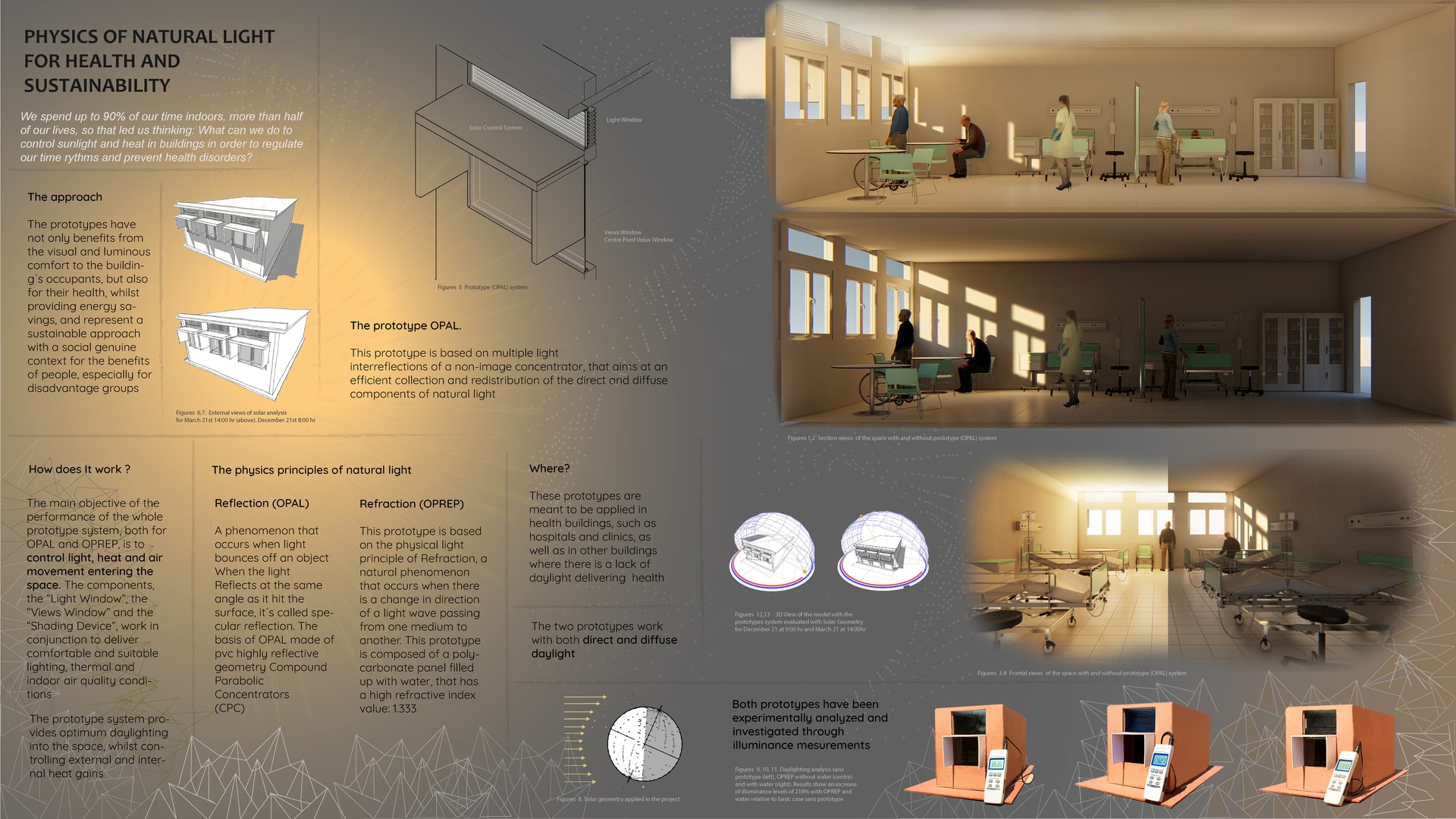Project Description
We spend up to 90% of our time indoors, that is, more than half of our lives, so, that leads us thinking ¿what can we do to control sunlight and heat in buildings in order to regulate our time rhythms and prevent health disorders? Certainly, a lack of daylight can severely disturb our circadian rhythm and provoke severe health problems. Much research suggests that our daily light dose is too small to keep us healthy. Nowadays there are not suitable daylight guidelines focused on taking care of the health of building occupants, even though numerous research and studies are widely available. Thus, a reconnection of daylight to the daily and seasonal rhythms of nature is urgently needed. This project focusses on the physics of natural light, Reflection and Refraction, in applied in two alternative prototypes: OPAL and OPREP. The first one called Optimum Parabolic Light Reflector (OPAL) is based on multiple light interreflections of a non-image concentrator, that aims at an efficient collection and redistribution of the direct and diffuse components of natural light. The second prototype is based on the physical light principle of Refraction and is called: Optimum Refractive Panel (OPREP). The approach: These prototypes are particularly meant to be applied in health buildings, such as hospitals and clinics, as well as in other buildings, where there is a lack of daylight, providing visual and luminous comfort to occupants, whilst delivering the health benefits of daylight. In most cases, the windows of these buildings deliver natural light only a few meters away from the openings. On the other hand, the windows of these buildings do not have a suitable solar control, and this results in external heat gains entering the space that provoke uncomfortable thermal conditions for the occupants. Therefore, the whole prototype system is composed of a window on the upper section of the fenestration called “light window”, calculated and designed to admit sunlight and/or daylight from the exterior and bouncing it through multiple interreflections on the ceiling and then distributed it uniformly on the active or resting areas of the spaces. In order to achieve effective control of the external heat gains, a lower section of the fenestration system called: “view window”, is implemented with a shading device for controlling the entrance of the heat during the overheating period of the location, whilst providing the necessary views to the outside as well as effective natural ventilation. A Velux Centre Pivot Window with double glazing and a “U” value of 1.2 W/m2K and visible transmittance of 0.78, was proposed to be installed in this section of the fenestration. The operable system of this window type also promotes the air renovation of the space to fulfill the requirements of indoor air quality. The main physical principle applied in this prototype is Reflection, a phenomenon that occurs when light bounces off an object. If the surface is smooth and shiny, like glass, water, or polished metal, the light will reflect at the same angle as it hit the surface. This is called specular reflection. OPAL will be made of a high 92% reflective white PVC layers, and it is based on the geometry of the multiple interreflections of compound parabolic concentrators (CPC). The second prototype, OPREP is based on the physical light principle of Refraction, a natural phenomenon that occurs when there is a change in direction of a light wave passing from one medium to another. This prototype is composed of a polycarbonate panel filled up with water, with a high refractive index of 1.333. The prototype will also be located in the “light window” section of the building and will deliver suitable daylight and appropriate distribution of the luminous flux, aimed at providing visual and luminous comfort to occupants, whilst delivering the multiple health benefits of natural light. OPREP can perform effectively both under direct sunlight as well as under diffuse daylight. The materials of both prototypes are low cost and easily available. The assembly mechanism is simple, removable for maintenance, and versatile for its operation. To sum up, both prototypes have been experimentally analyzed and investigated, and are aimed at integrating them in both new and existing health buildings. In the case of OPREP, the experimental arrangement consisted of 3D scale models evaluated for their illuminance conditions with and without the OPREP, and the results showed an increase of 218% relative to the base case. Therefore, the prototypes have not only benefits from the visual and luminous comfort to the building´s occupants, but also for their health, whilst providing energy savings, and represent a sustainable approach with a social genuine context for the benefits of people, especially for disadvantage groups.
